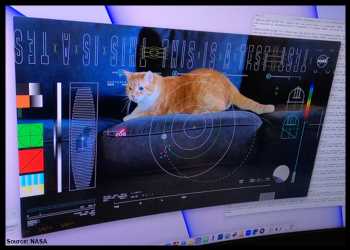First Ultra-high Definition Streaming Video Sent From Space
NASA’s Deep Space Optical Communications experiment beamed an ultra-high definition streaming video from a record-setting 19 million miles away from earth.
The video, featuring a cat named Taters, was sent back from nearly 80 times the Earth-Moon distance by NASA’s laser communications demonstration.
The U.S. space agency achieved this historic milestone as part of a technology demonstration aimed at streaming very high-bandwidth video and other data from deep space – enabling future human missions beyond Earth orbit.
“This accomplishment underscores our commitment to advancing optical communications as a key element to meeting our future data transmission needs,” said NASA Deputy Administrator Pam Melroy. “Increasing our bandwidth is essential to achieving our future exploration and science goals, and we look forward to the continued advancement of this technology and the transformation of how we communicate during future interplanetary missions.”
The demo transmitted the 15-second test video via a cutting-edge instrument called a flight laser transceiver. The video signal took 101 seconds to reach Earth, sent at the system’s maximum bit rate of 267 megabits per second (Mbps). Capable of sending and receiving near-infrared signals, the instrument beamed an encoded near-infrared laser to the Hale Telescope at Caltech’s Palomar Observatory in San Diego County, California. Each frame from the looping video was then sent live to NASA’s Jet Propulsion Laboratory in Southern California, where the video was played in real time.
The laser communications demo, which launched with NASA’s Psyche mission on October 13, is designed to transmit data from deep space at rates 10 to 100 times greater than the state-of-the-art radio frequency systems used by deep space missions today. As Psyche travels to the main asteroid belt between Mars and Jupiter, the technology demonstration will send high-data-rate signals as far out as the Red Planet’s greatest distance from Earth.
“It paves the way for higher-data-rate communications capable of sending complex scientific information, high-definition imagery, and video in support of humanity’s next giant leap: sending humans to Mars,” NASA said in a stetement.
“One of the goals is to demonstrate the ability to transmit broadband video across millions of miles. Nothing on Psyche generates video data, so we usually send packets of randomly generated test data,” said Bill Klipstein, the tech demo’s project manager at JPL. “But to make this significant event more memorable, we decided to work with designers at JPL to create a fun video, which captures the essence of the demo as part of the Psyche mission.”
“Despite transmitting from millions of miles away, it was able to send the video faster than most broadband internet connections,” said Ryan Rogalin, the project’s receiver electronics lead at JPL.
Source: Read Full Article

